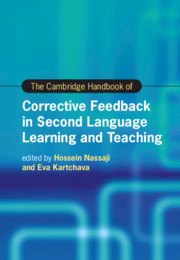Book contents
- The Cambridge Handbook of Corrective Feedback in Second Language Learning and Teaching
- Cambridge Handbooks in Language and Linguistics
- The Cambridge Handbook of Corrective Feedback in Second Language Learning and Teaching
- Copyright page
- Contents
- Figures
- Tables
- Contributors
- Acknowledgments
- Introduction Corrective Feedback in Second Language Teaching and Learning
- Part I Theoretical Perspectives on Corrective Feedback
- Part II Methodological Approaches in the Study of Corrective Feedback
- Part III Different Delivery Modes of Corrective Feedback
- Part IV Feedback Provider, Feedback Intensity, and Feedback Timing
- Part V Corrective Feedback and Language Skills
- Part VI Contexts of Corrective Feedback and Their Effects
- 22 Corrective Feedback in Second versus Foreign Language Contexts
- 23 Corrective Feedback in Computer-Mediated versus Face-to-Face Environments
- 24 Corrective Feedback in Mobile Technology-Mediated Contexts
- 25 Oral Corrective Feedback in Content-Based Contexts
- Part VII Learners’ and Teachers’ Feedback Perspectives, Perceptions, and Preferences
- Part VIII Individual Differences, Tasks, and Other Language- and Learner-Related Factors
- Index
- References
24 - Corrective Feedback in Mobile Technology-Mediated Contexts
from Part VI - Contexts of Corrective Feedback and Their Effects
Published online by Cambridge University Press: 26 February 2021
- The Cambridge Handbook of Corrective Feedback in Second Language Learning and Teaching
- Cambridge Handbooks in Language and Linguistics
- The Cambridge Handbook of Corrective Feedback in Second Language Learning and Teaching
- Copyright page
- Contents
- Figures
- Tables
- Contributors
- Acknowledgments
- Introduction Corrective Feedback in Second Language Teaching and Learning
- Part I Theoretical Perspectives on Corrective Feedback
- Part II Methodological Approaches in the Study of Corrective Feedback
- Part III Different Delivery Modes of Corrective Feedback
- Part IV Feedback Provider, Feedback Intensity, and Feedback Timing
- Part V Corrective Feedback and Language Skills
- Part VI Contexts of Corrective Feedback and Their Effects
- 22 Corrective Feedback in Second versus Foreign Language Contexts
- 23 Corrective Feedback in Computer-Mediated versus Face-to-Face Environments
- 24 Corrective Feedback in Mobile Technology-Mediated Contexts
- 25 Oral Corrective Feedback in Content-Based Contexts
- Part VII Learners’ and Teachers’ Feedback Perspectives, Perceptions, and Preferences
- Part VIII Individual Differences, Tasks, and Other Language- and Learner-Related Factors
- Index
- References
Summary
This chapter discusses the role of corrective feedback in mobile technology-mediated contexts. It begins by briefly discussing the role of technology in second language learning and teaching, focusing on mobile technology and explaining its affordances. It then examines the role that mobile-assisted language learning (MALL) can play in providing and monitoring corrective feedback in language learning. The chapter concludes with a discussion of the pedagogical implications as well as directions for future research on MALL-supported corrective feedback.
Keywords
- Type
- Chapter
- Information
- The Cambridge Handbook of Corrective Feedback in Second Language Learning and Teaching , pp. 520 - 538Publisher: Cambridge University PressPrint publication year: 2021
References
- 2
- Cited by

